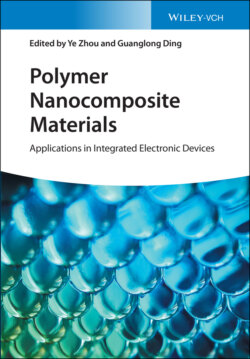Читать книгу Polymer Nanocomposite Materials - Группа авторов - Страница 41
2.4.1 Strain Sensor
ОглавлениеAs a device for detecting object deformation, CPC based strain sensors have been widely used for health monitoring, electronic skin, wearable electronics, etc. For the purpose of monitoring, the resistance (conductive networks) should response upon external strain/stress [119]. Thus, CPCs should possess excellent resilience such that the material could be elongated under external strain (destruction of conductive networks) and recovered immediately after the removal of the stress (reconstruction of conductive networks).
Conductive natural rubber/elastomer composites decorated with different conductive nanofillers are explored as promising candidates of wearable strain sensors [110, 126, 127]. The sensors show broad workable sensing range, high sensitivity, and excellent recoverability. Among these materials, conductive fabric composite strain sensors have shown promising applications in wearable electronics, thanks to their breathability, skin affinity, and so on [128, 129]. For example, they can be incorporated into clothing or gloves to detect human body motions [111, 114] and detect the motions of human body as shown in Figure 2.6. Figure 2.6a–d demonstrate that the fiber strain sensor could be used for human–machine interfaces by simply incorporating the fiber composites onto a glove, demonstrating the potential application in remote control of hand robot. Figure 2.6e–j show sensing performance of the smart integrated glove in monitoring motions like head-forward, shoulder imbalance, kyphosis, etc. In order to improve the environmental suitability of the sensors, self-protective CPCs with superhydrophobicity have attracted great interests [128, 130] from the academia. This superhydrophobicity endows the sensor with self-cleaning behavior and can prevent the water or even corrosive solution diffusion into the materials, which can extend their applications in some harsh conditions. To reveal the strain sensing mechanism, the evolution of conductive network of the CPC under different strains is observed by using the SEM [126].
Hydrogel as a new type of conductive polymer composite demonstrating preferable bio-compatibility, self-healing, and self-adhesiveness is an ideal material for strain sensing usage [131, 132]. Zhang et al. [133] developed a MXene (Ti3C2Tx)/PVA hydrogel sensor with outstanding sensing performance by mixing MXene nanosheet with PVA hydrogel. The hydrogel composite shows outstanding stretchability, self-healing property, and strong adhesiveness to skin, which can adhere to human skin without the assistance of bonding materials to detect subtle motions including facial expression, vocal signals, handwriting, and finger bending, demonstrating high accuracy and sensitivity.
